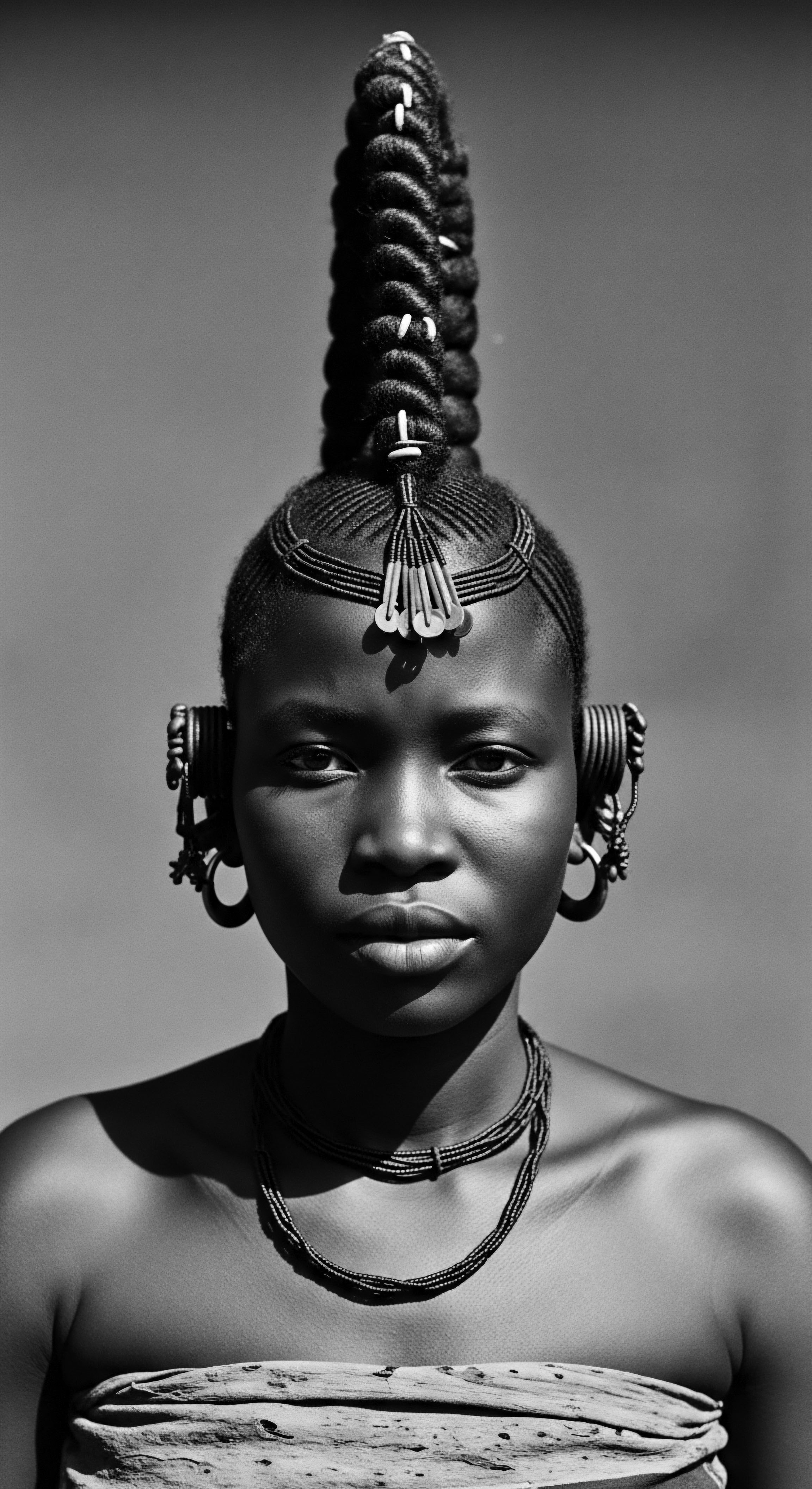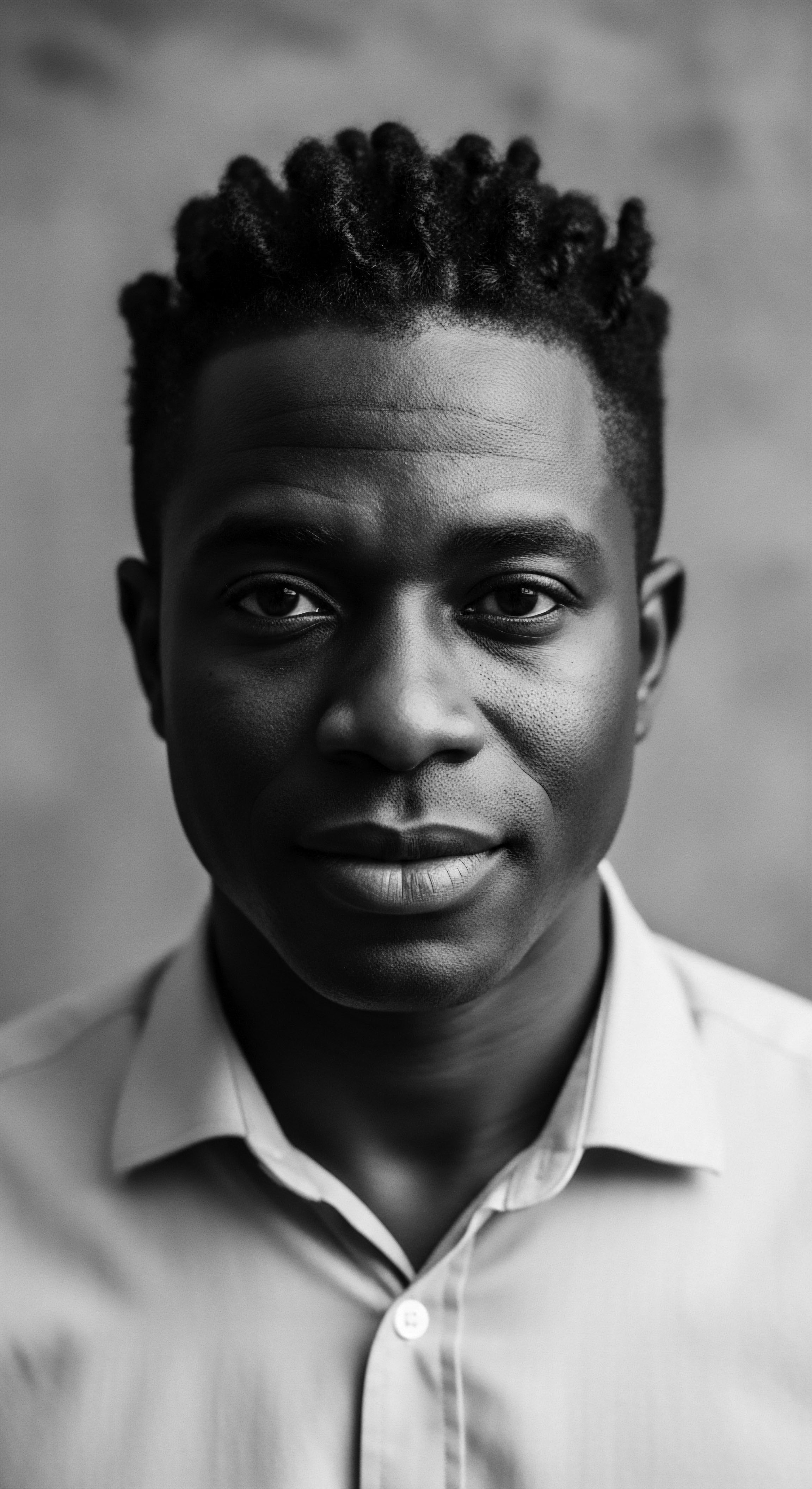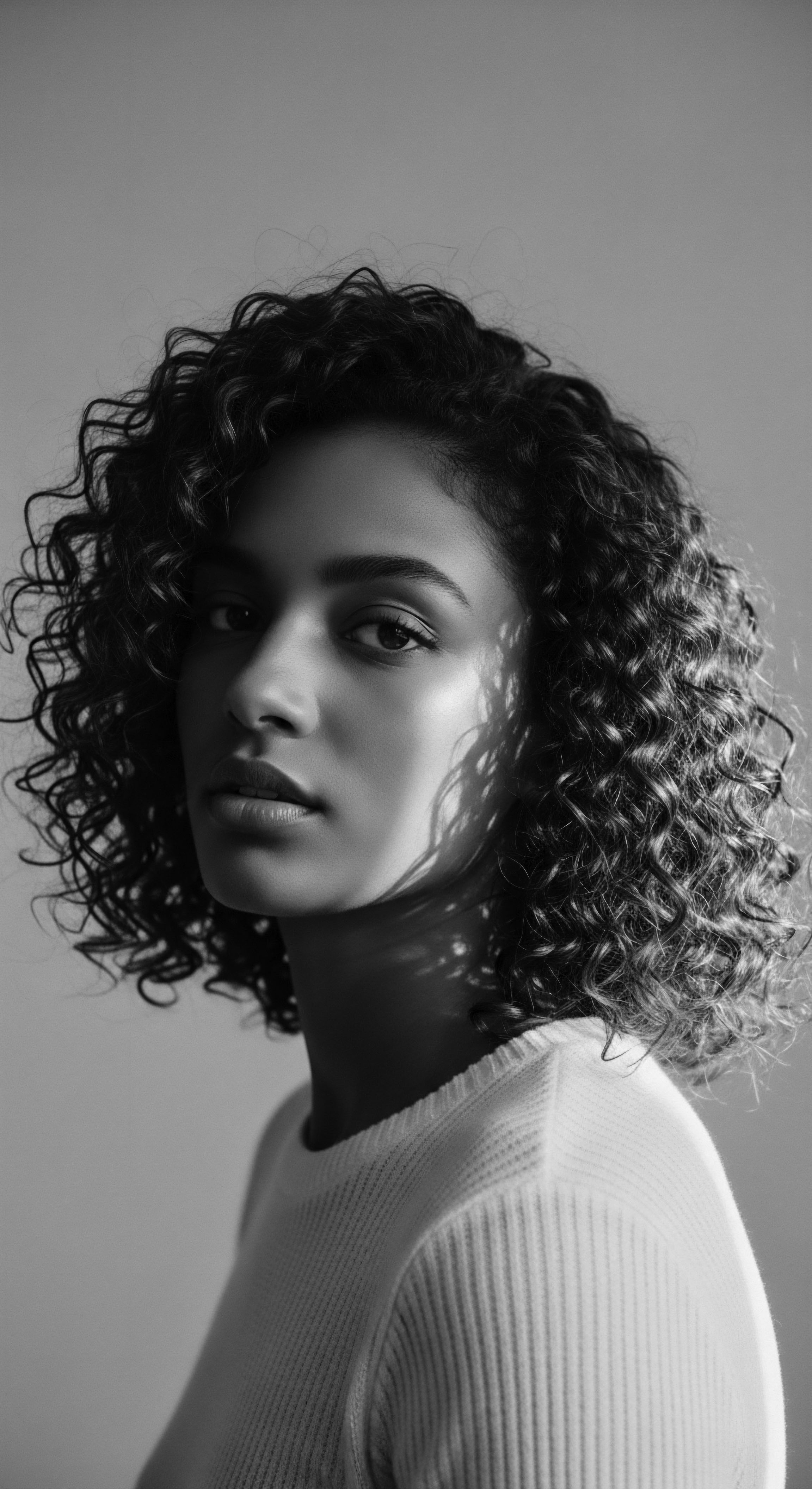
Roots
The very fibers of our textured hair carry ancestral memory, a deep inscription of journeys taken, wisdom gathered, and resilience upheld. Each coil, every gentle wave, speaks a language older than written script, a silent testament to generations who honored and tended their crowns. When we consider how mindful engagement with our choices today might fortify this enduring legacy, we are truly listening to these echoes, making selections that celebrate a profound inheritance. It is a dialogue between past and present, a conscious act of reverence for the inherited architecture of our strands.

Inherited Architecture of Hair
Understanding textured hair begins not merely with its outward appearance, but with the intricate cellular composition passed down through lineage. The unique helical structure of our hair, its elliptical cross-section, and the distinctive arrangement of disulfide bonds contribute to its characteristic curl patterns. From a scientific perspective, these characteristics dictate how light reflects, how moisture is retained, and how each strand responds to care. Yet, this understanding is incomplete without acknowledging the traditional knowledge that predates modern microscopy.
Our ancestors, through keen observation and lived experience, recognized these distinctions in texture, formulating practices and elixirs that worked in harmony with the hair’s inherent nature. They understood, without formal scientific terms, the importance of lubrication for strands that naturally resisted the easy downward flow of oils from the scalp, developing rich butters and plant-derived infusions for this purpose.
Our textured hair, with its unique anatomical design, holds a profound ancestral memory, guiding us toward care practices that honor its inherent structure.

Ancestral Categorization of Texture
While contemporary systems categorize textured hair by numbers and letters, often through a lens that inadvertently centers straight hair as a baseline, traditional societies possessed their own intricate classifications. These ancient methods seldom relied on a universal scale. Instead, they often drew from a localized understanding, noting differences in curl tightness, density, and natural luster as indicators for appropriate care or for cultural significance. In various West African communities, for instance, hair types might have been distinguished by their resemblance to elements of nature—the tight spirals of certain shells, the waves of a river, or the dense canopy of specific trees.
These weren’t arbitrary distinctions; they were practical guides for selecting specific herbs, oils, and styling techniques, often tied to social status, age, or spiritual practice. Such ancestral frameworks remind us that understanding our hair is not just about scientific labels; it also pertains to recognizing its place within a broader cultural lexicon.

Lexicon of Adornment and Care
The language surrounding textured hair care is as rich and layered as the strands themselves. Historically, terms for hairstyles and care practices carried deep cultural weight, often signifying tribal affiliation, marital status, or life passages. Words like Cornrows, Locs, and Braids are not merely descriptions of styles; they represent ancient techniques of manipulation and adornment.
Long before the modern beauty industry, ancestral communities utilized a language of natural ingredients—shea butter, various plant extracts, and specific clays—each possessing an understood role in nurturing hair. These traditional lexicons, rooted in a collective communal wisdom, speak to a time when hair care was an integrated part of daily life and communal ceremony, a practice of deep connection to self and lineage.

Cycles of Growth and Traditional Influence
The journey of a single hair strand, from its anagen growth phase through catagen and telogen, mirrors the cyclical nature of life itself. Understanding these phases, and the factors that nurture robust growth, was not lost on our ancestors. Their deep connection to natural rhythms informed practices that supported healthy hair ❉ diets rich in specific plant foods for internal nourishment, scalp stimulation through gentle massage, and protective styles that safeguarded fragile ends from the elements.
Environmental conditions, seasonal shifts, and available local botanicals all played a part in shaping these care routines. This ancient wisdom, often passed down through oral tradition, points to a holistic understanding of hair health, recognizing it as an outward sign of inner vitality and generational wellbeing.
Consider the profound economic and communal impact fostered by figures such as Madam C.J. Walker in the early 20th century. Born to parents who were formerly enslaved, Walker built a beauty empire centered on hair care products specifically designed for Black women. Her enterprise, rooted in Indianapolis, created an extensive network of sales agents—the “Walker Agents”—providing thousands of African American women with independent economic opportunities at a time when such avenues were scarce.
This historical example speaks volumes about the interwoven relationship between individual hair care, collective self-sufficiency, and the preservation of identity amidst systemic barriers. These agents did not simply sell products; they disseminated knowledge, built community, and collectively fortified a sense of agency that extended far beyond the realm of personal grooming. The conscious act of developing and consuming products within this network contributed directly to the economic empowerment of Black women, thereby strengthening the heritage of self-reliance and communal uplift.

Ritual
From the foundational understanding of hair’s inherent structure, we move to the living traditions that have shaped its care through the ages. These are the practices, the quiet moments of tending, and the communal gatherings that have elevated hair care into a ritual, a sacred act of preservation and identity. Conscious consumption, in this light, becomes a mindful participation in a continuum of heritage, discerning choices that honor ancestral techniques while adapting to the present. It calls for an awareness of how our purchases and practices contribute to the viability and vibrancy of these enduring traditions.

Why Do Protective Styles Safeguard Legacy?
Protective styles, such as Braids, Twists, and Locs, extend beyond mere aesthetic choices; they are historical artifacts, each telling a story of ingenuity and survival. Their origins lie deep within African traditions, serving not only as adornment but also as practical solutions for safeguarding hair from environmental aggressors, symbolizing social rank, or conveying tribal affiliation. These styles minimize manipulation, reduce breakage, and allow hair to rest and retain length. Today, choosing a protective style can be an act of quiet rebellion against Eurocentric beauty norms, a reclamation of cultural memory, and a practical approach to hair health.
When we support artisans skilled in these traditional techniques, or brands that honor the heritage of these styles through ethical production, we consciously participate in keeping this ancestral artistry alive. This support helps ensure that the skills, passed down through generations, remain viable, preserving an intangible cultural asset.

Natural Styling Echoes Ancestry
The pursuit of natural styling and definition is a return to roots, a celebration of the hair’s intrinsic curl, coil, or wave pattern. Techniques like finger coiling, wash-and-gos, and twist-outs find their conceptual predecessors in ancestral methods that sought to enhance, not alter, the hair’s natural texture. Historically, plants like aloe vera, hibiscus, and various clays were employed to define curls, add sheen, and provide gentle hold without harsh chemicals. These practices underscore a deep reverence for the hair’s natural state.
Modern conscious consumption here involves seeking out products that utilize these time-honored ingredients, sourced sustainably and ethically, from companies that prioritize hair health over fleeting trends. It is a discernment that looks beyond surface promises to the deeper alignment with ancestral principles of purity and efficacy.
Hair extensions and wigs, often perceived as contemporary accessories, possess a long and storied heritage within Black communities. From ceremonial adornments in ancient Egypt to West African societies where hair was often supplemented for volume or symbolic purposes, these tools have served diverse functions. During periods of enslavement and thereafter, extensions sometimes offered a means of conforming to imposed beauty standards, but they also served as creative expressions of identity and status within constrained circumstances.
- Ancient Use ❉ Wig-making in ancient Egypt served both aesthetic and hygienic purposes, with elaborate designs often symbolizing status.
- West African Traditions ❉ Many West African cultures incorporated fiber and hair extensions for ceremonial styles, indicating marital status or age.
- Diasporic Adaptation ❉ In the diaspora, extensions and wigs became versatile tools for both protective styling and self-expression, often against a backdrop of societal pressure.

Tools of Our Forebears and Today
The tools used in textured hair care offer another direct link to our past. Simple combs crafted from wood or bone, picks for detangling, and various implements for braiding and sectioning were essential in ancestral practices. These implements were often designed with the hair’s unique structure in mind, promoting gentle manipulation and minimizing stress.
Today, the conscious consumer considers not only the efficacy of a tool but also its longevity, its materials, and the ethics of its production. Choosing durable, well-designed tools that mirror the thoughtful engineering of traditional implements—like wide-tooth combs or brushes with flexible bristles—aligns with a heritage of mindful consumption.
| Traditional Tools Wooden Combs (often wide-toothed, handcrafted) |
| Modern Counterparts/Link to Heritage Wide-tooth detangling combs, designed for gentle passage through coils. |
| Traditional Tools Bone Picks (for styling, sectioning) |
| Modern Counterparts/Link to Heritage Metal or plastic styling picks, emphasizing volume and lift. |
| Traditional Tools Natural Fibers (for braiding extensions) |
| Modern Counterparts/Link to Heritage Synthetic or human hair extensions, with ethical sourcing as a growing priority. |
| Traditional Tools The continuity of form and function in hair tools across generations speaks to an enduring wisdom concerning textured hair. |

Relay
The journey from ancestral whispers to contemporary practices culminates in the ‘Relay’—the passing forward of knowledge, values, and practices that shape the future of textured hair care. This is where conscious consumption truly becomes a powerful force, acting as a conduit for cultural preservation, economic equity, and environmental responsibility. It is a sophisticated engagement with the market, informed by historical understanding and driven by a desire to strengthen the legacy of textured hair for generations yet to come.

What Role Does Conscious Consumption Play in Economic Justice?
Conscious consumption within the textured hair community extends beyond ingredient lists; it reaches into the very fabric of economic justice. For centuries, the wealth generated from Black hair care has not always recirculated within the communities that drive its demand. Supporting Black and mixed-race owned businesses is a deliberate act of reinvestment, directly combating historical disenfranchisement and building generational wealth. These businesses often possess an intrinsic understanding of textured hair’s unique needs and cultural significance, born from lived experience.
Choosing to spend with them means affirming cultural expertise and contributing to the self-determination of communities that have long been marginalized in the beauty industry. It also means holding larger corporations accountable, demanding transparency in their supply chains and equitable representation at all levels.
The beauty industry’s engagement with textured hair has, at times, been problematic, marked by cultural appropriation or a lack of genuine understanding. Conscious consumption challenges this by empowering consumers to demand authenticity and respect. When consumers prioritize brands that are truly aligned with the values and heritage of textured hair care—those that consult with community elders, collaborate with culturally competent scientists, and give back to the communities they serve—they send a clear market signal.
This signal encourages genuine innovation rooted in understanding, rather than superficial attempts to capitalize on cultural trends. It is a collective vote for integrity and a rejection of practices that disregard the deep roots of textured hair traditions.
Conscious consumption acts as a powerful lever for economic justice and cultural affirmation within the textured hair community, channeling resources to those who truly understand and honor its legacy.

How Do Ingredient Choices Revere Ancestral Wisdom?
The selections we make regarding ingredients hold a direct link to ancestral practices and ecological stewardship. Our forebears relied on botanicals readily available in their environments, understanding their properties through generations of empirical observation. Shea butter from West Africa, argan oil from North Africa, and various herbal infusions found across diasporic communities were not chosen arbitrarily; they were selected for their profound nourishing and protective qualities. Conscious consumption compels us to look beyond fleeting scientific claims and to seek out products that incorporate these venerable ingredients, sourced ethically and sustainably.
This means prioritizing brands that ensure fair trade practices, support indigenous farmers, and minimize their environmental footprint. By doing so, we respect both the ancestral wisdom embedded in these ingredients and the ecological systems from which they derive, ensuring their availability for future generations.
A commitment to transparency in product formulations allows consumers to make informed choices that align with their values. This extends to understanding the provenance of ingredients, the labor practices involved in their harvesting and processing, and the overall environmental impact of a product’s lifecycle. The heritage of textured hair care, particularly in its earliest forms, was inherently transparent, relying on readily identifiable natural components. Reclaiming this transparency in modern consumption reinforces the values of purity and intention that defined ancestral care rituals.
- Shea Butter ❉ A staple from West Africa, prized for its profound moisturizing and sealing properties.
- Coconut Oil ❉ Historically used across various tropical regions for its ability to penetrate the hair shaft and condition.
- Aloe Vera ❉ Valued for its soothing and hydrating qualities in many traditional healing systems.

Can Conscious Choices Shape Future Narratives?
The very act of making conscious choices about textured hair care contributes to a dynamic, unfolding narrative. It moves the story of our hair beyond historical struggles and into a realm of empowerment and celebration. By investing in products and practices that honor our heritage, we validate the inherent beauty and strength of textured hair, not as a trend, but as an enduring aspect of identity.
This collective action helps dismantle lingering colonial beauty standards and cultivates a positive self-perception, particularly for younger generations. It reinforces the idea that textured hair is not something to be “managed” or “tamed” but rather to be celebrated, understood, and adorned.
Furthermore, conscious consumption plays a part in the scientific understanding and innovation within textured hair care. By supporting brands that invest in culturally competent research—research that respects the unique physiology of textured hair and seeks solutions tailored to its needs—consumers accelerate genuine progress. This can lead to the development of new products that are genuinely beneficial, free from harmful chemicals, and formulated with a deep respect for both scientific rigor and ancestral principles. It represents a forward trajectory that is firmly rooted in the past, a relay race where each generation carries the torch of knowledge and self-affirmation.

Reflection
The exploration of conscious consumption’s role in fortifying the heritage of textured hair care practices reveals a profound truth ❉ our choices today are not isolated acts, but vital contributions to an unfolding legacy. Each thoughtfully selected product, every intentional moment of care, becomes a deliberate acknowledgment of the wisdom passed down through generations. It is in this mindful engagement—this listening to the Soul of a Strand—that we truly preserve and uplift the deeply resonant narratives of Black and mixed-race hair.
The journey of our hair, from elemental biology and ancient practices, through living traditions of care and community, to its powerful voice in shaping identity and futures, remains a living archive. By consciously tending to its past, we safeguard its present, and ensure a vibrant, honored path for its continued story.

References
- A’Lelia Bundles. On Her Own Ground ❉ The Life and Times of Madam C. J. Walker. Scribner, 2001.
- Byrd, Ayana D. and Lori L. Tharps. Hair Story ❉ Untangling the Roots of Black Hair in America. St. Martin’s Griffin, 2014.
- Rooks, Noliwe M. Hair Raising ❉ Beauty, Culture, and African American Women. Rutgers University Press, 1996.
- White, Shane and Graham White. Stylin’ ❉ African American Expressive Culture from Emancipation to the Present. Cornell University Press, 1998.
- Akbar, Na’im. Chains and Images of Psychological Slavery. New Mind Productions, 1996.
- Patton, Tracey Owens. “African American Hair and Social Justice.” Journal of Black Studies, vol. 43, no. 6, 2012, pp. 605-623.
- Wilkins, David. “The Cultural Significance of Hair in the African Diaspora.” Journal of American Folklore, vol. 122, no. 484, 2009, pp. 127-148.
- Mercer, Kobena. “Black Hair/Style Politics.” Welcome to the Jungle ❉ New Positions in Black Cultural Studies. Routledge, 1994.
